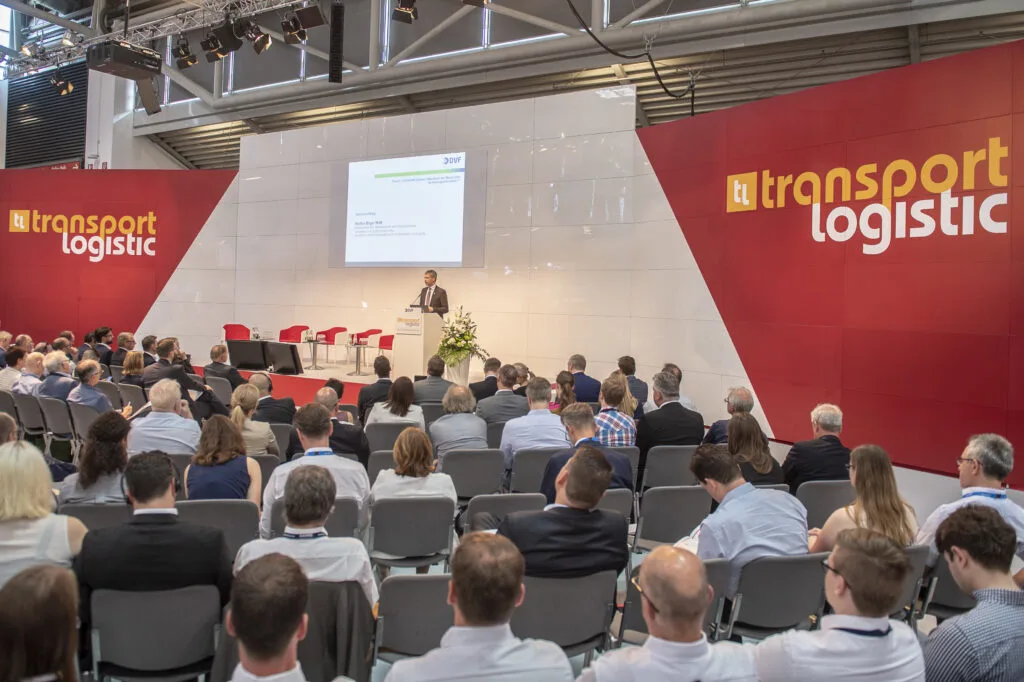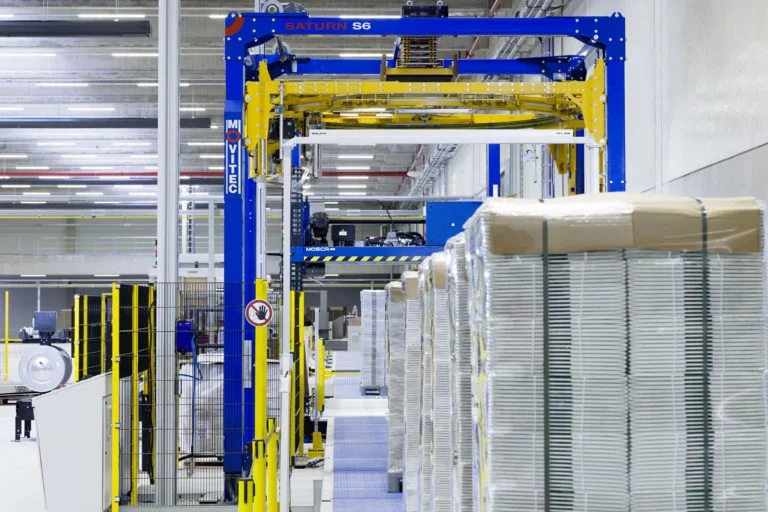transport logistic 2025 (TL Munich) will take place from June 2 to 5th at the Messe München exhibition centre and will once again be the meeting place for the international logistics industry, with a curated conference. Immediately after the official opening on the first day of the trade fair at 11:00, the conference program will start with around 150 specialist events on current topics from logistics, mobility, IT and supply chain management: the Conference, Campus Plaza, Exhibitor Stage and exhibitor events will provide information on companies, people and the environment. Key topics include cooperation, artificial intelligence, cybersecurity and much more, with constructive ideas about issues such as infrastructure and people bottlenecks. On the whole, the topics show that markets and technologies are changing rapidly, mainly driven by geopolitics, digitalization and sustainability.
Top-class panels
The conference program fills 60 slots in four forums with presentations and discussions across all modes of transport and sectors. A total of 154 large and small logistics brands will present themselves on the stages in Halls A1, A2, A3 and B1. The focus will be on market developments with risks and opportunities, as well as processes and solutions. Many conference presentations will focus on achieving maximum efficiency with minimum emissions.
The perspectives range from deep dives into sectors such as chemicals, automotive and consumer goods to high-level discussions such as talks at the 13th mariLOG conference on changes in maritime logistics chains with Angela Titzrath (CEO of Hamburger Hafen Logistik) and Rolf Habben Jansen (CEO of Hapag Lloyd), among others.
Campus Plaza enters its second round
After its successful premiere, the transport logistic Campus Plaza is now entering its second round. Experts and interested parties will meet in Hall A3.323/424 on the networking platform with short presentations. The topics of cybersecurity, sustainability, artificial intelligence and employers will be examined from different perspectives for one day each. Among the 19 presentations already registered are brands such as Dekra, DP World, Arvato, Dako and Unisys, with more yet to come.
TL Munich conference
With 33 presentations on the Exhibitor Stage (Hall B5.133/234) and 29 events at trade fair stands so far, exhibitors are rounding off the program of transport logistic & air cargo Europe 2025. The participating companies include renowned players such as Kühne & Nagel, Rhenus Logistics, Mercedes-Benz Trucks, AEB, SVG and Gruber Logistics. As part of their activities, initiatives are organizing pitch rounds for startups. The named topics include “Logistics for the future” by Your German Logistics and “Logistics Changers: Startups rock logistics” by Logistik-Cluster Schwaben. The ÖBB Rail Cargo Group will host a locomotive naming ceremony on the open-air site.
air cargo Europe: a high-level meeting
As the world’s largest meeting place for air cargo, air cargo Europe (acE) occupies Halls A1 and A2. With the motto “At the cutting edge”, the industry’s key players will give talks in four panel discussions on topics including the future of AI and sustainability. Another highlight of the acE conference will be a discussion on the “Fight against Greenhushing”, which refers to the concealing of data for fear of false reports. This discussion was initiated by Women in Aviation and Logistics. On June 3 at 18:00, the industry will celebrate the ACW World Air Cargo Awards.
Markets are changing rapidly
At an international level, the world of logistics is preoccupied with “Global supply chains in transition” (BVL), developments such as “My Nation First—Antiglobalization, trade wars, hot wars” (Club of Logistics) and “Future of Air Freight and Freighters”. The continuing wave of insolvencies is causing concern for SMEs. The Federal Association of Freight Transport and Logistics (BGL) will provide a status report on this while the Verkehrsrundschau will pose the question: “Medium-sized transport companies: phased-out model or model for the future?”. The Expert Council on Digital Transformation in Transport and Logistics will discuss “How freight forwarders are mastering change” in a panel. Key players from business and research will comment on market developments, including major brands such as IKEA, Alfred Kärcher, Andreas Schmid Logistik and VDO/Continental.
Key topic: digitalization
Across all modes of transport and logistics markets, companies, researchers and associations are working to digitalize processes and solutions. The primary goal is to achieve maximum efficiency with minimum emissions. Artificial intelligence is seen as an important lever here. Its application scenarios along the supply chain focus on the last mile (German Parcel and Express Logistics Association (BPEX)) or examine their influence on the competitiveness of rail freight transport (Rail Business). Another focus is on forms of cooperation in supply chains. Among other things, the Open Logistics Foundation is moderating two discussion rounds on open-source solutions for electronic delivery bills and zero-emission solutions. The BVL will shed light on the downside of the unhindered flow of data with the topic “Cybersecurity in logistics: How supply chains remain secure in the digital age” based on a recently published study. The Federal Office for IT Security (BSI) will provide deep knowledge in a forum on the particularly vulnerable area of air freight. Innovations on the Exhibitor Stage will offer in-depth insights into practical applications, including multimodal processes and specialist areas such as customs.
Sustainability has a stage
The environment, people and companies are considered to be the pillars of sustainability. They run through many contributions in the conference program: research projects (Logistik Initiative Hamburg), electric mobility (Verkehrsrundschau) or ESG (BVL/DSLV) with emission calculation (IVE). Technologies and applications, especially for transportation management, will be presented on the Exhibitor Stage and at the exhibitor talks. Rail has a place in the conference program and unfolds its potential in combined transport. As an environmentally friendly alternative, it will conquer the stage with several performances. The Forum in Hall A3 is a focal point. Obstacles and opportunities, trends and developments, technologies and sensible investments will be highlighted by the Association of German Transport Companies (VDV), among others, with the question “How can non-craneable trailers be transported by rail?”, while an alliance of industry and sector representatives will clarify why “every meter counts” when it comes to service areas and tracks (LKZ Prien). The German Transport Forum (DVF) is developing ideas for the future: “Reshaping Combined Transport: How do we take combined transport to a new level?”
No logistics without people
The last day of the trade fair will be dedicated to HR topics. Interactive sessions lasting four hours each will focus on employer branding with the Wirtschaftsmacher (Forum Hall A2) and developments in the world of work with a focus on women with LogWorkPINK (Forum Hall A1). In discussions with transport companies, Verkehrsrundschau will examine the best strategies to combat the shortage of trainees and skilled workers. The Chamber of Industry and Commerce for Munich and Upper Bavaria is tackling the shortage of professional drivers with “Immigration — just do it!” and the Augsburg University of Applied Sciences is curbing fluctuation with research results and packages of measures on the subject of “motivating drivers”.
The programme reflects the industry
“The conference program is growing as the industry becomes more significant. We are proud of the great commitment of the exhibitors, media and partners. transport logistic is an important platform for discourse in the logistics community,” says Dr. Robert Schönberger, Global Industry Lead transport logistic & air cargo Europe exhibitions at Messe München. The panel discussions and lectures will be held in German or English and will be translated simultaneously. Attendance at the conference program is included in the ticket price.
similar news











